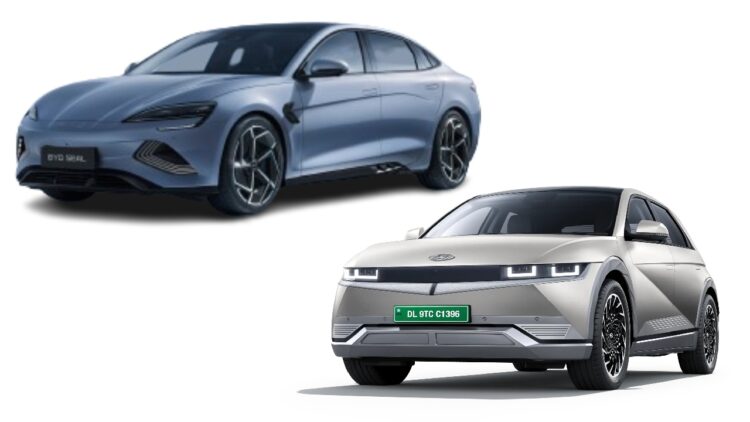In this post, we shall compare the BYD Seal and Hyundai Ioniq 5. BYD is prepping the launch of its third EV in India on March 5, 2024. Seal is based on the e-Platform 3.0. Its exterior design draws inspiration from its Ocean X series. In the international markets, it rivals the iconic Tesla Model 3. BYD also offers Atto 3 and e6 electric MPV in India. On the other hand, the Ioniq 5 is among the most popular and successful EVs from Hyundai across many international markets. Let us take a look at the details of this comparison.
You may also like: Hyundai Ioniq 5 Shows Supreme Build Quality in First-Ever Crash in India
BYD Seal vs Hyundai Ioniq 5 Specs Comparison
BYD Seal
For the Indian market, the Seal will offer a dual-motor setup powered by either a 61.4 kWh or a 82.5 kWh battery pack. The former is good for a decent range of 550 km, while the larger battery can take the EV to around 700 km (CLTC) on a single charge. The smaller battery uses 110 kW DC fast charger, whereas the larger battery can charge using a 150 kW DC fast charger. The combined power output is a whopping 523 hp which enables a 0 to 100 km/h acceleration time of just 3.8 seconds. It boasts a full 5-star Euro NCAP safety rating. It measures 4,800 mm in length, 1,875 mm in width and 1,460 mm in height.
You may also like: Tesla Model 3 and Model Y vs Hyundai Ioniq 5 – Comparison
Hyundai Ioniq 5
The Hyundai Ioniq 5 shares the same Electric Global Modular Platform (E-GMP) architecture as its sedan counterpart, the Ioniq 6. It packs a 72.6 kWh battery. This powers an electric motor capable of producing 160 kW (equal to 217 hp) and 350 Nm of peak power and torque. You can charge the vehicle using a 350 kW DC fast charging system, which can take you from 10% to 80% charge in just 18 minutes. Alternatively, a 150 kW DC fast charger achieves the same charge level in 21 minutes. The car can utilize both 800V and 400V charging equipment and features a useful V2L (Vehicle-to-Load) function, allowing you to power external devices. This high-end electric vehicle boasts an ARAI-certified range of 631 km on a single charge. It measures 4,635 mm in length, 1,890 mm in width and 1,625 mm in height.
| Specs | BYD Seal | Hyundai Ioniq 5 |
| Battery | 61.4 kWh or 82.5 kWh | 72.6 kWh |
| Power | 523 hp | 217 hp |
| Range | 700 km (CLTC) | 631 km (ARAI) |
| Charging | 150 kW DC | 350 kW DC |
| Length | 4,800 mm | 4,635 mm |
| Width | 1,875 mm | 1,890 mm |
| Height | 1,460 mm | 1,625 mm |
| Platform | e-Platform | E-GMP |
You may also like: Hyundai Ioniq 5 Becomes Shahrukh Khan’s First-Ever Electric Car
Features Comparison
The features list on both these cars is quite lengthy. The Seal will boast premium features like soft-touch materials, a 15.6-inch rotating touchscreen infotainment display, a 10.25-inch digital driver’s instrument cluster, head-up display, two wireless charging pads, ADAS functions and much more. More details will arrive at the launch. On the other hand, the Ioniq 5 also offers tons of modern amenities. These include things like SmartSense Level 2 ADAS with 21 functions, a 12.3-inch Touchscreen Infotainment System, Shift-by-Wire gear changes, Virtual Engine Sound System (VESS), Hands-free Powered Tailgate, BlueLink Connected Car Tech with 60+ Features, and more, V2L, use of recycled materials for upholstery, minimalistic interior and more. Hence, both these are packed to the brim.
You may also like: 600 hp Hyundai Ioniq 5 N Spied on Test with Elantra N
You may also like: Ashneer Grover Trolls BYD Atto 3 with Tesla Badge
Author’s Note
This is an interesting comparison. This EV segment is gaining popularity in our market for quite some time now. However, we can only make an informed decision once we know all the details of the BYD Seal. We shall update this section then.



